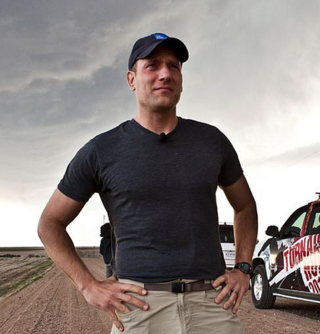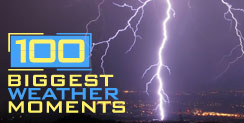
The Weather Channel (TWC) is an American pay television channel owned by Weather Group, LLC, a subsidiary of Allen Media Group. The channel's headquarters are located in Atlanta. Launched on May 2, 1982, the channel broadcasts weather forecasts and weather-related news and analysis, along with documentaries and entertainment programming related to weather. A sister network, Weatherscan, was a digital cable and satellite service that offered 24-hour automated local forecasts and radar imagery. Weatherscan was officially shut down on December 12, 2022. The Weather Channel also produces outsourced weathercasts, notably for CBS News and RFD-TV.
James D. Cantore is an American meteorologist. He is best known as an on-air personality for The Weather Channel.
WeatherStar is the technology used by American cable and satellite television network The Weather Channel (TWC) to generate its local forecast segments—branded as Local on the 8s (LOT8s) since 2002 and previously from 1996 to 1998—on cable and IPTV systems nationwide. The hardware takes the form of a computerized unit installed at a cable system's headend. It receives, generates, and inserts local forecasts and other weather information, including weather advisories and warnings, into TWC's national programming.

Local on the 8s is a program segment that airs on the American network The Weather Channel. It provides viewers with information on current and forecasted weather conditions for their respective area; a version of this segment is also available on the channel's national satellite feed that features forecasts for each region of the United States. The name comes from the timing of the segment, as airs at timeslots that end in "8" ; because of this manner of scheduling, the forecast segments air on the channel in ten-minute intervals. From 2006-2013, each forecast segment had usually been preceded by a promo for one of The Weather Channel's programs or services, leading into the segment with the announcer stating "And now, your Local on the 8s". On November 12, 2013, the promo segment was replaced by an intro that was built into the Local on the 8s segment. As of April 2018, the segment airs at approximately :18 past each hour. It also usually airs at approximately :48 past each hour during live Weather Channel broadcasts. On July 11, 2023, the music for Local on the 8s was replaced with band and jazz music.

Michael Bettes is an American television meteorologist and storm chaser who works for The Weather Channel in Atlanta, Georgia. He was a co-host of AMHQ: America's Morning Headquarters. He hosts Weather Underground TV. Bettes has been an on-camera meteorologist for TWC since 2003, and is also an occasional fill-in weather anchor on The Today Show.

It Could Happen Tomorrow is a television series that premiered on January 15, 2006 on The Weather Channel. It explored the possibilities of various weather and other natural phenomena severely damaging or destroying America's cities. This included: a Category 3 hurricane hitting New York City, an F4 tornado destroying Washington, D.C., dormant volcano Mount Rainier re-activating and destroying towns in the surrounding valleys, a tsunami flooding the Pacific Northwest coast, an intraplate earthquake impacting Memphis, Tennessee, wildfires spreading into the heart of San Diego, a huge earthquake leveling San Francisco, a flash flood in Boulder, Colorado, and a flood in Sacramento. More recent episodes included an earthquake in Las Vegas, an F5 tornado ripping its way through Chicago and Dallas, and more.

Gary England is the former chief meteorologist for KWTV, the CBS-affiliated television station in Oklahoma City, Oklahoma. England was the first on-air meteorologist to alert his viewers of a possible tornado using a commercial Doppler weather radar. He is also known for contributing to the invention of the First Warning map graphic commonly used to show ongoing weather alerts without interrupting regular programming. Currently, Gary is the Vice President of Corporate Relations and Weather Development at Griffin Communications LLC, the parent company to KWTV-DT, although the company uses the same single-story building as the studio.
Gregory Stanley Forbes is The Weather Channel's long-time severe weather expert and has a significant research background in the areas of severe convective storms and tornadoes.
In broadcasting, local insertion is the act or capability of a broadcast television station, radio station or cable system to insert or replace part of a network feed with content unique to the local station or system. Most often this is a station identification, but is also commonly used for television or radio advertisements, or a weather or traffic report. A digital on-screen graphic, commonly a translucent watermark, may also be keyed (superimposed) with a television station ID over the network feed using a character generator using genlock. In cases where individual broadcast stations carry programs separate from those shown on the main network, this is known as regional variation or an opt-out.

100 Biggest Weather Moments was a 2007 five-part miniseries on The Weather Channel, that premiered on Sunday, April 15, and aired nightly through Thursday, April 19, the biggest documentary effort in The Weather Channel's 25-year history.
Weather Center Live was an American weather news television program on The Weather Channel. Airing in various timeslots throughout the daytime hours and serving as The Weather Channel's de facto flagship forecast program, it features weather forecasts, analysis and weather-related feature segments. This program, the current incarnation of Weather Center, debuted on March 2, 2009.
The Weather Channel is an American basic cable and satellite television channel owned by Byron Allen's Entertainment Studios that focuses on national and international weather information; although in recent years, the channel has also incorporated entertainment-based programs related to weather on its schedule. This article details the history of the channel, which dates back its founding to around 1980.

America's Morning Headquarters is an American morning television program on The Weather Channel. Airing every morning from 6 a.m. to 12 p.m. Eastern Time, the program focuses on morning weather conditions, news and business information from around the country. The program debuted on January 3, 2000, under its original title. If there is a major weather event, it used to air until 10 am, however since 2017, it's usually cut back an hour for additional live broadcasts for Weather Center Live.

Weekend Now was a weekend weather program on The Weather Channel that aired from 11 a.m.-2 p.m. Eastern time on Saturdays and Sundays. The program, which originally featured unique segments including world weather, lifestyle-oriented weather, and light weather news, debuted in 2001 as the first of multiple weekend programs on The Weather Channel.
The Hearst Media Production Group is an American media and production company based in New York City, New York as a division of the Hearst Television subsidiary of Hearst Communications, with three additional offices in Boston, Washington, D.C., and Burbank, California. Many of HMPG's programs comply with federally mandated educational and informational requirements.

Storm Riders is a reality television series following two meteorologists as they travel across the Great Plains and East Coast of the United States in search of thunderstorms, tornadoes, and other severe weather. Storm Riders was aired on The Weather Channel, and it was included on the channel's Tornado Week programming.

Winter storm naming in the United States has been used sporadically since the mid-1700s in various ways to describe historical winter storms. These names have been coined using schemes such as the days of the year that the storm impacted or noteworthy structures that the storm had damaged and/or destroyed. In the 2010s, winter storm naming became controversial with The Weather Channel coming up with its own list of names for winter storms similar to that of hurricanes. The marketing of weather became a big part of media revenue by the 1990s. Various other media outlets soon followed The Weather Channel with their own naming lists. Most government and research meteorologists argue that winter storms can reform more than once, making the process of naming them both difficult and redundant. The United States National Weather Service (NWS) has refrained from commenting on the system and stated that they do not name winter storms.

The February 2016 North American winter storm was a strong winter storm that caused more than 70,000 people in southern California to lose their electricity, with many broken trees and electrical lines in that area, with the Southern Rocky Mountains having the potential to receive some of the greatest snowfall from the system. One person in San Diego, California area died when a tree fell on their car. Another person in Minnesota died after being struck by a car while crossing a street.

Local Now is an American over-the-top internet television service owned by The Weather Group, LLC, a subsidiary of Entertainment Studios. A spinoff of The Weather Channel, Local Now primarily provides a cyclic playlist of weather, news, sports, entertainment and lifestyle segments, incorporating localized content through feeds geared to a user-specified area.

The March 2019 North American blizzard was a powerful Colorado Low that produced up to two feet of snow in the plains and Midwest. Rapid snowmelt following the storm caused historic flooding, and some areas received hurricane-force wind gusts. Comparable to the 1993 Storm of the Century, the storm was labeled a bomb cyclone after barometric pressure readings dropped in excess of 24 mbar (0.71 inHg) over a 24-hour period. After the storm entered Colorado from its origination in Arizona, the pressure dropped more than 30 mbar (0.89 inHg) and rapidly intensified over the western High Plains. The severe storm set new all-time record low barometric pressure readings in Colorado, Kansas and New Mexico. The storm itself killed only one person in Colorado, but flooding caused by the storm killed at least 3, one in Iowa and at least two in Nebraska and left ~140,000 without power in Texas.













